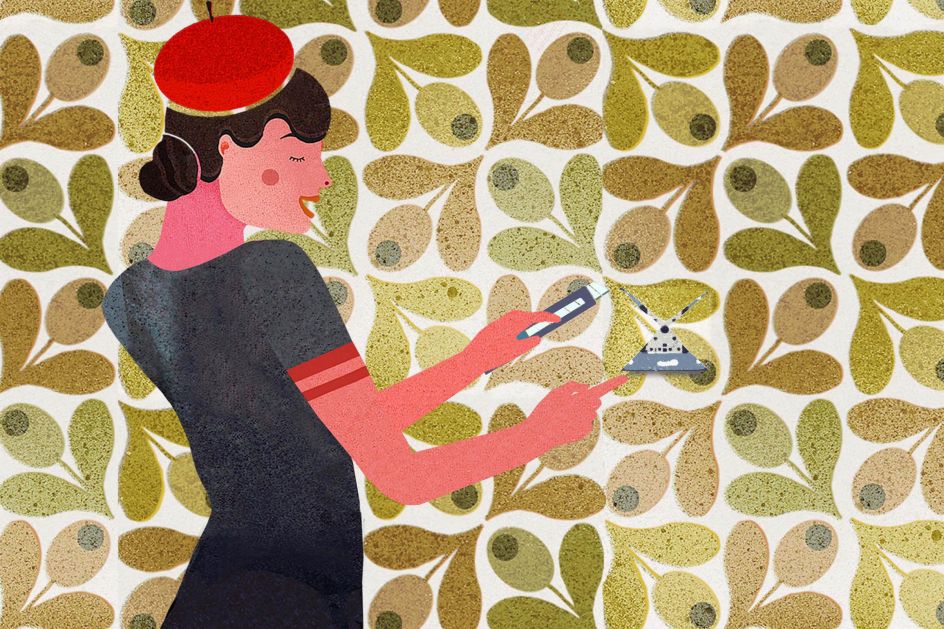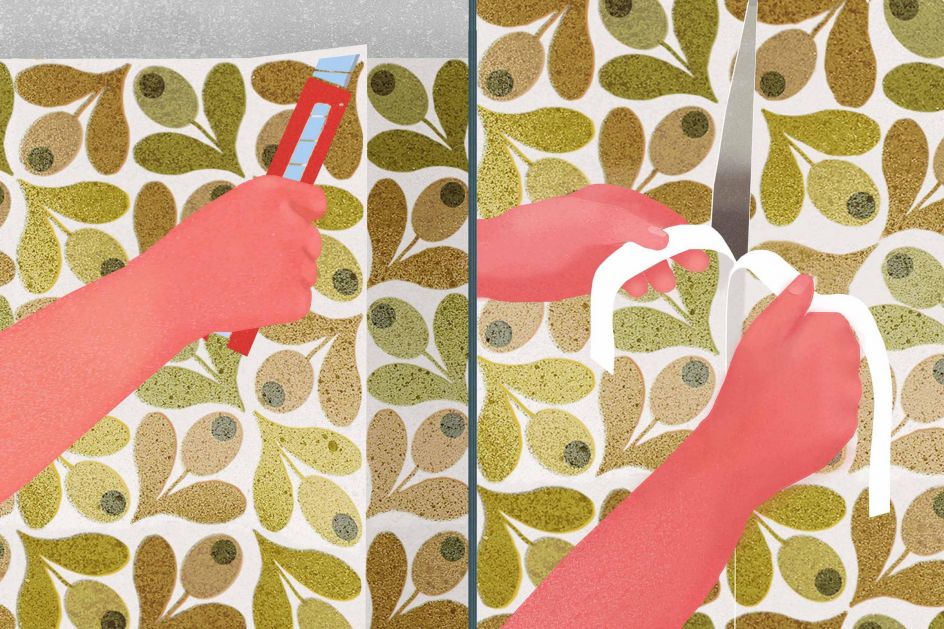Nobody likes them, but even with the greatest care, they are inevitable: damages of all shapes and sizes, of many different types and to various extents. It's just in the nature of things that the wall with damaged wallpapers will almost always be in full view. It seems that our eyes are magically drawn to the damaged area. It soon becomes a source of irritation and will annoy us constantly.
Repairing the damage can be quite a challenge, especially with patterned or motif wallpapers, or those with a high-quality structure or special surface. But fear not: with our useful hints and tips, you'll be on top of the situation in no time. With a bit of skill and patience, many issues can be solved quite easily. Having said that, more significant types of damage sometimes simply cannot be repaired - but there are a few tricks that will conceal the problem.
Don't worry about damages
Accidents will happen, and so it is inevitable that the odd sharp object will fly through the air, land on the wallpaper and take a small piece of it with it. Moving furniture, day-to-day housework or putting nails and screw into walls can also have a negative effect on walls and wallpaper. And if your beloved pet decides to sharpen its claws on the wall, it's not only time to fix the damage but also to tackle the reasons (see: The cat's (or dog's) whiskers! Which wallpapers are suitable for pet owners?).
Children often play in lounges and kitchens, and this can lead to unwanted marks on wallpaper, too. This is completely normal, and there are solutions for most problems - and if there aren't, there are some tricks that can help cover up any damages - and there's always the thought of a new wallpaper to make you feel better! It's certainly something to look forward to...
Basic tools for wallpaper repairs
You are probably aware that it is always a good idea to order a bit more of your chosen wallpaper - an extra roll (or better yet, two) will come in handy if you need to do some repairs. Once the wallpaper paste has been mixed, it can only be used for a certain amount of time - and if you need it for repairs months or even years later, it certainly isn't usable any longer. Ready-mixed repair adhesive is available in DIY shops in tubes, or as a liquid concentrate made especially for those cases. Depending on wallpaper characteristics, you can choose between different types of adhesive. If you need to replace entire lengths/strips of wallpaper, you should mix a new packet of wallpaper paste.
Soft, lint-free cloth and rags, fine paintbrushes, a seam roller and a cutter knife are essential repair tools. Set everything up within reach and always make sure you have enough time on your hands and aren't under time pressure or stress.
Open Seams
This isn't damage in the true sense, but one of the most frequent problems after wallpapering. It is also unsightly. Armed with a tube of special wallpaper glue and a fine paintbrush, you can fix the open seam in no time. First of all, lift the wallpaper along the seam as carefully as possible in order to be able to treat all dry areas beneath. Then apply the glue to the wall or the underside of the wallpaper and use a clean cloth to carefully smooth it back in place. Now remove any surplus glue with another clean cloth, dry the area and go over it with a seam roller. Voilà! Done and dusted!
Typical damages and how to do repairs and touch-ups
There follows an overview over the most common damages and reasons for wallpaper repairs (and the best solutions, too!).
The top layer is damaged but the wallpaper hasn't come off
Sometimes just the top layer is slightly damaged, but it hasn't come off or hangs off the wall. In those cases, you can use wallpaper paste or adhesive to carefully stick the top layer onto the carrier material. Please take extra care when pressing the top layer onto the carrier material, as it might rip once wet.

Part of the wallpaper has to be replaced
If a small or larger area of the wallpaper is damaged (e.g. scratched), has a hole in it or has been in contact with chemicals and other staining substances which cannot be washed off, you need to replace the damaged part with a new piece of wallpaper.
To do this, simply use a pencil and a ruler to draw a frame (square or rectangular, depending on the size and shape of the damage) around the area. Now use your cutter knife to cut the area out and remove the damaged piece. Depending on the type of wallpaper you are working with, you might need to dampen the cut-out area with soapy water first (for paper-based types, score the area first so the water can penetrate the paper). For non-woven varieties, you can simply pull the whole piece off.
If you are dealing with patterned wallpapers or those with a special surface structure, it might be necessary to experiment a little bit. From a wallpaper cut-off or a new wallpaper roll, choose a piece that aligns with the pattern of the damaged strip. Cut a replacement piece the same size of the piece you cut out PLUS 5 cm on each side. Now hold the new piece over the cut-out area on the wall, aligning the pattern/structure. Use your cutter knife to cut along the line where the cut-out area and the new piece overlap to create the perfect piece to fit into the "empty space" (Double Seam Cut). If there are bits of the wallpaper below sticking out, you can cut those off carefully.

If you need to do the repair on your own, use a smoothing trowel to hold the piece in place whilst cutting it. Alternatively, take a piece of sticky tape, form a loop and use it as "double-sided" tape to temporarily hold the wallpaper in place - it is easy to remove it afterwards.
Before putting up the replacement wallpaper piece, check the wall. Damages often go deeper, which might necessitate treating the actual wall surface. If dispersion adhesive was used to put up the wallpaper, you first need to remove all remnants of the adhesive. In order to ensure that the new piece will stick to the wall properly, the wall beneath it needs to be clean and smooth - you might even have to apply some deep primer.
Replacing entire strips of wallpaper
If the entire strip of wallpaper is damaged or dirty, it might be easier to just remove the whole strip and replace it with a new one. An example for this would be a new power line involving long cuts in the brickwork.
Non-woven wallpapers are especially suitable for replacing whole strips as they can simply be pulled off. Nevertheless, it is advisable to act with caution so the adjacent strips aren't damaged in the process. For paper-based, vinyl and other wallpaper types that need to be scored and soaked before removal, the risk of damaging adjacent strips is even greater, so think before you act.
When cutting the new strip of wallpaper, please remember to add the rapport and pay special attention to the pattern alignment. If the wallpaper adhesive is put directly onto the wall, special care should be given to the side seams towards the "neighbouring" strips. Damp remnants of adhesive should immediately be removed from the undamaged strips. Find more useful tips regarding pattern alignment and rapport in our wallpaper guide How to cut wallpaper correctly.
As with partial replacements, the surface needs the be checked before putting up new strips of wallpaper.

Tips regarding partial replacement pieces and entire strips of wallpaper
Wallpapers are exposed to light and other environmental influences as soon as they have been put up on the wall. That means that - depending on light-resistance and durability - colours and the overall look will change with time. Colours fade, become lighter, or dust and dirt in the air can settle in the structure and make the wallpaper appear darker after a while. New pieces or strips of wallpaper haven't been exposed to these influences and will naturally look brighter and fresher in terms of colour, especially just after the repair.
This is worth pointing out as the pieces or strips of wallpapers can be even more obvious than the original damages. Our recommendation: Before you start your repair project, compare the wallpapers by pinning a largish piece of the new wallpaper next to the damaged bit on the wall. If you cannot discern a difference, you're in luck. However, if the differences are quite obvious, you might want to rethink your repair project as it can take quite a while for the new piece to look like the old one.
If the repair went wrong: Here are a few hand tricks to make damages disappear:
Sometimes, the repair just doesn't work - or even makes the problem worse! Very small blemishes are often not worth the effort of a repair job, and there are other, quick and easy solutions to deal with these minor issues.
Our little tricks are probably not new to anyone, as many people use them quite intuitively. Depending on the size of the damage, you can cover it with pictures, banners, tapestry or other wall decorations. Mirrors are a good option, too; they create the impression of space and do not clash with any patterned wallpapers.
Alternatively, cupboards or chests of drawers can be placed in front of the damaged area - moving furniture around creates new perspectives, and many interior designers recommend doing it from time to time to liven up your environment. It's the equivalent of the proverbial "killing two birds with one stone".
Around windows, opulent drapes or long curtains can be effective in hiding damages, and they help keep the warmth in and curious eyes out.

